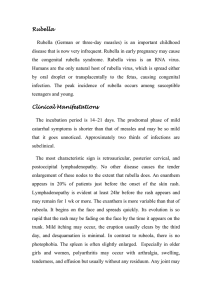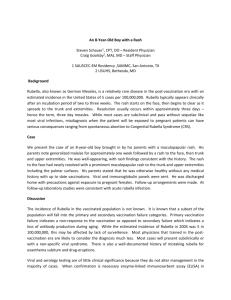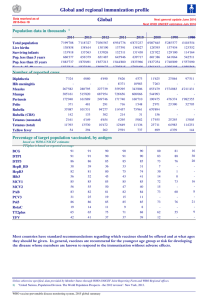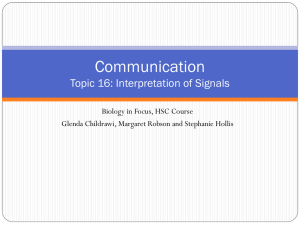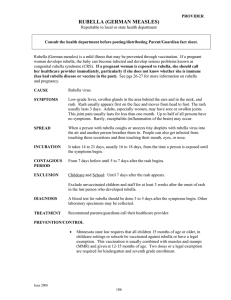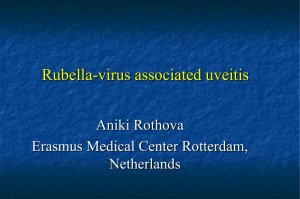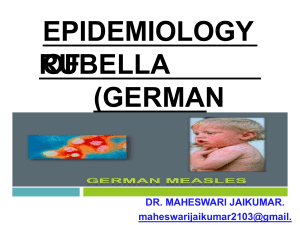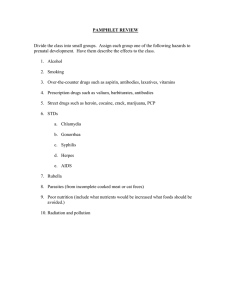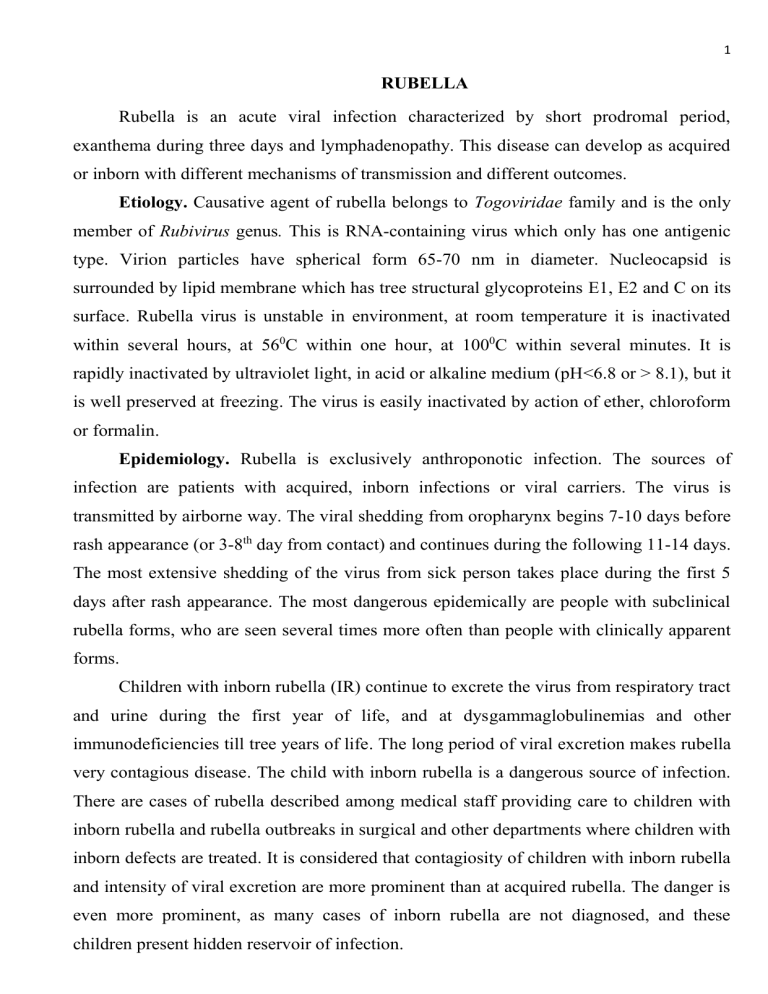
1 RUBELLA Rubella is an acute viral infection characterized by short prodromal period, exanthema during three days and lymphadenopathy. This disease can develop as acquired or inborn with different mechanisms of transmission and different outcomes. Etiology. Causative agent of rubella belongs to Togoviridae family and is the only member of Rubivirus genus. This is RNA-containing virus which only has one antigenic type. Virion particles have spherical form 65-70 nm in diameter. Nucleocapsid is surrounded by lipid membrane which has tree structural glycoproteins Е1, Е2 and С on its surface. Rubella virus is unstable in environment, at room temperature it is inactivated within several hours, at 560С within one hour, at 1000С within several minutes. It is rapidly inactivated by ultraviolet light, in acid or alkaline medium (pH<6.8 or > 8.1), but it is well preserved at freezing. The virus is easily inactivated by action of ether, chloroform or formalin. Epidemiology. Rubella is exclusively anthroponotic infection. The sources of infection are patients with acquired, inborn infections or viral carriers. The virus is transmitted by airborne way. The viral shedding from oropharynx begins 7-10 days before rash appearance (or 3-8th day from contact) and continues during the following 11-14 days. The most extensive shedding of the virus from sick person takes place during the first 5 days after rash appearance. The most dangerous epidemically are people with subclinical rubella forms, who are seen several times more often than people with clinically apparent forms. Children with inborn rubella (IR) continue to excrete the virus from respiratory tract and urine during the first year of life, and at dysgammaglobulinemias and other immunodeficiencies till tree years of life. The long period of viral excretion makes rubella very contagious disease. The child with inborn rubella is a dangerous source of infection. There are cases of rubella described among medical staff providing care to children with inborn rubella and rubella outbreaks in surgical and other departments where children with inborn defects are treated. It is considered that contagiosity of children with inborn rubella and intensity of viral excretion are more prominent than at acquired rubella. The danger is even more prominent, as many cases of inborn rubella are not diagnosed, and these children present hidden reservoir of infection. 2 Transmission route at acquired rubella is airborne. Rubella is easily transmitted at close and prolonged contact. Virus presence in urine and stool of patients with rubella does not exclude contact route of transmission. Presence of viremia justifies intrauterine transmission from mother to fetus. Through third people rubella is not transmitted. Immunity after episode of rubella is stable, long-term. Pathogenesis. At acquired rubella the entrance route for virus is oropharyngeal mucosa. Primary replication of the virus most probably occurs in epithelial cells of cheek mucosa. Then infection of oropharynx and upper respiratory tract lymphoid tissue occurs; later the virus spreads hematogenically and infects organs and systems. 7-9 days before rash appearance the virus can be found in nasopharyngeal mucus and blood, simultaneously with rash appearance in urine, cerebral spinal fluid and breast milk. In a week after rash onset viremia is over; it coincides with appearance of neutralizing IgM and IgG antibodies in blood. IgG antibodies are detected life-long in human body. At inborn rubella the virus penetrates the fetus with maternal blood. Frequency of pregnant woman infection after contact with rubella depends on presence of immunity to this infection. Half of infected pregnant women have subclinical form of the disease. Most of pathological changes which develop at inborn rubella are the results of virus-induced necrotizing vasculitis. The virus infects epithelium of chorionic villi and endothelium of placental blood vessels; from there the virus is transmitted into fetal blood flow in emboli. Development of pathological process resembles chronic infection. Frequency of embryonic infection reaches 80-90% if pregnant woman develops disease in first trimester, 25-35% in second trimester and 8-10% in third trimester of pregnancy. If rubella infection develops after 20 weeks of gestation, risk of birth defects is considerably lower; but infection during this term can lead to development of chronic disease of nervous system and sensory organs. After birth the virus persists in the body. This creates conditions for development of immunopathologic processes which are resulting into development of deafness, retinopathy, diabetes and encephalitis in a child with inborn rubella. Clinical manifestations. Acquired rubella. The main mechanism of infection transmission at acquired rubella is airborne. Through third people rubella is not transmitted. 3 Incubational period of acquired rubella is 11-21 days, more often 18 ± 3 days. In 2/3 of children rubella has subclinical course. Other children after completion of incubational period develop short prodromal period, from several hours till 1-2 days. It includes enlargement of occipital, post auricular and posterior cervical lymph nodes, which become indurated and tender at palpation. Their enlargement can be so prominent that can be seen visually. Besides lymphadenitis, at prodromal period there is also fever till 37.5-380С, mild catarrhal changes of mucosa, roseolar enanthema on hard palate. Prodromal period is more often seen in children of older age. Rubella has more sever course in this age. Skin rash appears simultaneously all over the body, rash character is roseolar and small macular papular in typical cases. Rash elements are confluent. The rash is most concentrated on extensor surfaces of extremities, back, buttocks, outer surface of thighs. On the second day or at the end of the first day the rash elements become much less in number, they become small macular and look like rash at scarlet fever. The rash disappears rapidly, during 1-3 days, without pigmentation or desquamation. Polyadenitis is a permanent sign of rubella. It is characterized by moderate enlargement of posterior cervical and occipital lymph nodes, more seldom of other groups as well. Lymphatic nodes are elastic to palpation, not united to other tissues, mildly tender. Enlarged lymph nodes can be found 5-10 days before rash appearance and within 1-2 weeks afterwards. In some cases lymphadenitis can remain for many years after episode of rubella. Catarrhal changes of upper respiratory tract and conjunctiva mucosa are not seen constantly, are mild and continue during 2-3 days. Adolescents and adults develop more severe course of rubella, which is presented by more prominent intoxication signs (headache, febrile fever, chills, myalgia) and catarrhal signs (dry cough, throat tickling, prominent conjunctivitis with lacrimation, photophobia, running nose). As a rule the rash is more abundant, macular-papular, with tendency for confluence. In this age, more often in girls, arthralgias and arthritis are seen which further are transformed into chronic. Clinically they present with pain, redness, joint swelling. Metacarpophalangeal joints of hands are more often affected, then knee joints and elbow joints. Symptoms of joint damage appear, as a rule, a week after rash onset; they disappear 4 within one week afterwards. School age boys can develop testalgias. Thrombocytopenia develops in rare cases, which can become chronic in 56% of cases. The most serious complication of rubella is encephalitis which has autoimmune character. More often encephalitis develops in school age children and adults. Rubella encephalitis is seen in 1 per 5-10 thousand cases of rubella. It most often evolves at the end of exanthema period but can develop several days before rash onset. Prognosis of central nervous system damage in rubella is serious, in 20-35% of cases lethal outcome occurs, and in 30% of children after the disease residual signs of nervous system damage are seen. Changes of complete blood count during rash period at rubella include leucopenia, lymphocytosis and increased number of plasmatic cells (Turk cells) till 10-15%. Inborn rubella. Early clinical presentations of the disease can be divided into transitory and irreversible. Transitory, early clinical presentations of the disease are caused by acute non-specific immune response to inborn viral infection. They include generalized lymphadenopathy, hepatosplenomegaly, intrauterine fetal developmental delay, hepatitis, jaundice, hemolytic anemia, pneumonia, meningoencephalitis, decreased bone density, diarrhea. Thrombocytopenic purpura, petechial rash, crimson rash (”Blueberry muffin”), which are areas of dermal erythropoesis, more often appear at rubella than at other inborn infections. However, these changes disappear during the first weeks of life, are quite well treated and usually do not present negative long-term consequences. In published book of N.Gregg in 1942 y. the typical inborn rubella birth defects are described, such as cataract, microphthalmia, retinopathy, corneal caligo, heart defects and low birth weight. Later deafness was also described. N.Gregg first described the classical triad of inborn rubella: cataract, hart defects and deafness. In the last 30 years classical triad of Gregg is seldom seen in children with inborn rubella. Besides pointed out syndromes, newborns also have microcephalus, glaucoma, cleft palate, interstitial pneumonia, hepatitis, myocarditis, meningoencephalitis, vestibular apparatus defects, urinary tract defects, dermatitis, thrombocytopenia, hemolytic anemia, hypogammaglobulinemia, dysembryogenic stigma (brachycephaly, auricle deformities, hip dysplasia, syndactyly, clubfoot, etc.). Irreversible changes are caused due to heart, eyes, brain and hearing organs damage. 5 Among heart defects the most commonly (78%) diagnosed is patent ductus arteriosus. Aortic valve insufficiency, aortic stenosis, aortic coarctation, ventricular septal defect and pulmonary stenosis are also diagnosed. At rubella atrial septal defect, aorta and pulmonary transposition can also be seen. Heart defects of “blue” type almost never develop at rubella. Cataract is the result of direct cytopathic action of rubella virus, which can persist in eye lens during several years. Cataract can be unilateral or bilateral and is often combined (in 60%) with microphthalmia. This anomaly can be absent at birth and can develop later in newborn period. Glaucoma is diagnosed much more seldom than cataract, in ratio 1:10, and can progress during newborn period. Glaucoma is almost never combined with cataract. Among eye defects retinopathy is often revealed, which is characterized by retinal areas of dark pigmentations and depigmentations. Eye changes can develop several years after birth. The most common birth defect at inborn rubella is deafness. It can be mild or severe, unilateral or bilateral. Mild forms are often diagnosed several years after birth. Deafness is often accompanied by vestibular dysfunction, the degree of which correlates with degree of deafness. Nervous system damage at inborn rubella presents with decreased alertness, sleepiness, irritability, seizures, decreased muscle tone, paralyses; in early postnatal period acute or chronic encephalitis can occur. Later motor disorder of different severity, hyperkinesias and seizures can be seen. Neurological symptoms also include intellectual developmental delay. Thrombocytopenic purpura develops right after birth and is most prominent on the first week after birth. Hemorrhagic rash on the skin can be present during 2-3 months. Typical presentations of inborn rubella also include damage of long bones (osteoporosis). This pathology is typical for rubella and is diagnosed at X-ray examination. It is characterized by alternations of areas of bone tissue rarefaction and consolidation. Unlike similar changes at syphilis, bone changes at rubella disappear 1-2 months later. Most of neonatal lesions also disappear within months. 6 Birth defects seen rarer at rubella include urinary tract defects (cryptorchism, hypospadias, hydrocele, uterus bicornis, bilobal kidneys), gastrointestinal tract defects (pylorostenosis, biliary duct atresia), different skin defects (dermatitis, pigment maculae), brain calcifications. Children with inborn rubella often have low body weight, lesser body length and considerable delay in physical development. During first 4 years of life about 16% of these children die. The death is most often due to heart defects, sepsis, defects of inner organs, intercurrent viral and bacterial infections. Prolonged period of follow up of children born to mothers with episodes of rubella during pregnancy showed that, if these children did not have any presentations during newborn period, they developed decreased intellectual abilities and changes of behavior on the 3-7th year of life and they could not study at regular schools. These children also are at risk of development of deafness, retinopathy, glaucoma, thyroiditis, diabetes mellitus (which has 4 times higher frequency than in healthy children), arterial hypertension, disease similar to schizophrenia. The fact of interest is that brain changes similar to those at inborn rubella are seen in brains of patients with schizophrenia. Diagnosis. Clinical criteria of acquired rubella: - acute onset of the disease; - fever till 37.5-380С; - transitory mild catarrhal changes of respiratory mucosa and conjunctive; - sometimes roseolar rash on hard palate; - enlargement and tenderness of posterior cervical and occipital lymph nodes; - prodromal period can continue for several hours; - rash appears on the first day of the disease; - rash is roseolar or small macular-papular; - rash elements do not merge; - rash appears simultaneously all over the body; - predominate localization of rash is on extensor surfaces of extremities, back, buttocks, outer surface of thighs; - rash disappears during 1-3 days, without pigmentations or desquamations; - girls of pubertal age can develop arthritis and arthralgia; 7 - boys of school age can present with testalgias; - rare presentation is thrombocytopenia. Clinical criteria of inborn rubella: Suspected case of inborn rubella in infant is probable history of maternal rubella during pregnancy or the child with birth heart defects and/or cataract, decreased vision fields, nystagmus, strabismus, microphthalmia, inborn glaucoma, suspected decreased hearing. Clinical case of inborn rubella is the case when the child has 2 pathologies from the list (а) or one pathologies from the list (а) and on pathologies from the list (b): а) cataract; glaucoma; inborn heart defects; decreased hearing; pigment retinopathy; б) purpura; splenomegaly; microcephaly; delay in psycho-motor development; meningoencephalitis; osteoporosis (X-ray confirmed); jaundice during the first 24 hours after birth. Paraclinical investigations Acquired rubella: 1. Complete blood count (leucopenia, neutrophilia, lymphocytosis, plasmatic cells, normal ESR); 2. Serological methods (reaction of neutralization, reaction of inhibition of hemagglutination, reaction of complement fixation, immunoenzyme analysis): antibody titer increase 4 times and higher in dynamics; 3. Immunoenzyme analysis: determination of specific antibodies of IgM class in acute period (1-2 weeks before rash appearance and till 3 weeks after its disappearance) and IgG titer increase in dynamics. 8 4. Viral antigen visualization by immune fluorescent methods 5. Polymerase chain reaction (blood, if necessary cerebral spinal fluid): rubella RNA identification. Inborn rubella: 1. Immunoenzyme analysis: detection of specific antibodies of IgM class in blood. The case of positive specific rubella IgM antibodies in a child without clinical presentation is considered to be inborn rubella infection. 2. Presence of high titers of specific IgG in blood during long period without their decrease. 3. Viral RNA identification (blood, urine, saliva, stool, cerebrospinal fluid) by PCR method. 4. Children, born to mothers with episode of rubella or with contact with rubella during pregnancy, should be followed till at least 7 years with obligatory regular examination by pediatrician, ophthalmologist, ENT and neurologist. Treatment. Currently there are no specific methods of treatment of both inborn and acquired rubella. Treatment of uncomplicated acquired rubella is done at home conditions: 1. Bed rest during acute period; 2. Hygienic measures; 3. Frequent ventilation of the living rooms; 4. Symptomatic treatment: antipyretics at fever (paracetamol, ibuprofen), etc. At development of complications the children are hospitalized into infectious hospitals. Management of children with inborn rubella depends on character of main clinical syndromes. Children with suspicion for inborn rubella or with clinical case of inborn rubella must be hospitalized into specially organized medical settings. These settings (separated wards) must be first of all created on the basis of profile hospitals which provide medical help to children with inborn defects (cardiovascular surgery, ophthalmology, neurology, neonatal intensive care unit). Prophylaxis. Specific rubella prophylaxis is performed by live rubella vaccine in age 12 months with further revaccination at 6 years. The vaccination can be done by 9 monovaccine or combined vaccine which includes vaccines against rubella, measles, mumps and varicella. Immunity is formed in 95% of vaccinated children. According to WHO recommendations, children with suspected inborn rubella or clinical case of inborn rubella must be hospitalized into specially organized in every region medical settings where these children will be followed by qualified pediatricians with experience of treatment of these children. These settings must be first of all created on the basis of profile hospitals which provide medical help to children with inborn defects (cardiovascular surgery, ophthalmology, neurology, neonatal intensive care unit, etc.). Questions for self-control: 1. Which group of viruses does rubella virus belongs to. 2. Epidemiological particularities of rubella virus. 3. Particularities of rubella pathogenesis. 4. Periods of rubella clinical course. 5. Characteristics of clinical forms of rubella. Concept of inborn rubella. Gregg’s triad. 6. Course and consequences of rubella. 7. Laboratory diagnosis, current methods and interpretation of results. 8. Prophylactic activities in rubella nidus. 9. Main approaches to rubella treatment. 10. Vaccination against rubella according to vaccination schedule. Tests for self-control 1. Which family does the rubella virus belong to? A. Togavirus B. Herpes C. Enterovirus D. Paramyxovirus E. Hepadnavirus 2. Choose the entrance route for rubella virus: A. Upper respiratory tract mucosa B. Skin C. Gastrointestinal tract D. Eyes mucosa E. All the answers are correct 3. Choose the most typical way of rubella transmission: A. Fecal-oral B. Airborne C. Contact D. Parentheral E. Vertical 4. Name the defect which is not included into triad of inborn rubella: A. Heart defects B. Cataract C. Deafness D. Anemia E. Thrombocytopenia 5. The following mechanism does not play a role in inborn rubella pathogenesis: 10 A. Presence of rubella virus in maternal respiratory tract B. Hematogenic and lymphogenic spread of the virus into fetal tissues C. Rubella virus tropism to embryonic tissues D. Dependence of fetal damage frequency from terms of pregnancy E. All the answers are correct 6. Rash character at rubella: A. Small macular B. Abundant rash on back, buttocks, extensor surfaces of extremities C. Absence of rash on palms and soles D. Rash is not predisposed to merging E. All the answers are correct 7. Which symptoms are not typical for rubella: A. Fever B. Small macular rash C. Enlargement of posterior cervical and occipital lymph nodes D. Rash is mostly large macular and papular E. Conjunctivitis 8. Name the methods which are not use for laboratory diagnosis of rubella: A. Virusological B. Bacteriological C. Serological D. PCR E. Antibody level by paired serum 9. Terms of isolation of patient with rubella: A. For 5 days from rash onset B. For 10 days from rash onset C. For 2 weeks from disease onset D. For 3 days from rash onset E. All the answers are correct 10. Name the immunity which is formed after episode of rubella: A. Long-lived B. Short-lived C. Type specific D. Serospecific E. Antitoxic Test answers 1-A, 2-A, 3-B, 4-D, 5-A, 6-E. 7-A, 8-B, 9-A, 10-A.
